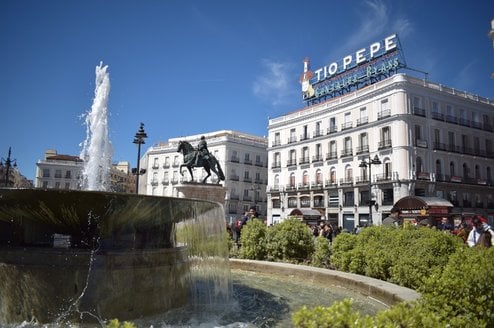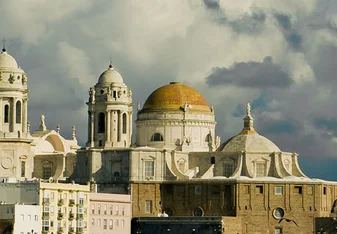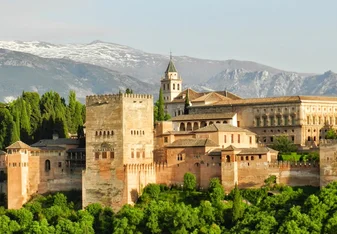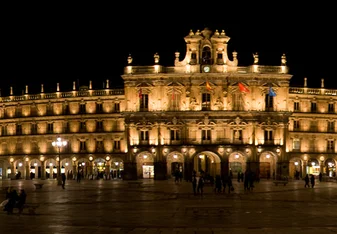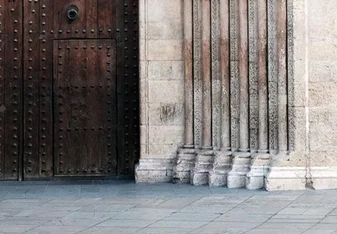Study Abroad Programs in Madrid
Study Abroad Programs in Madrid
Pagination
About
Madrid is one of those cities that is easy to fall in love with. An affair begins with the Spanish capital at the first glance of the Palacio Real, with the first bite of traditional Jamón, with the first stroll in El Parque del Retiro, or with your first experience at one of the many festivals exclusive to Madrileños, such as “La Noche en Blanco.” The history waiting to be discovered, the culture waiting to be lived, and the friendly Spanish people who are so eager to assist with learning the Spanish language are some of the many components that make Madrid an alluring destination for a student to live.
Popular destinations
Puerta del Sol
Puerta del Sol is a wonderful starting place. Recognizable by its two large fountains, and located centrally in Madrid, this famous plaza is the center of the radial network of Spanish roads, and was originally one of the gates to Madrid in the 15th century. Today, Sol is the ultimate meeting place for groups of friends trying to coordinate their Friday night. It is the equivalent of New York City’s Time Square - a bustling plaza full of street performers, club promoters and tourists taking pictures of the famous new year’s eve clock above Casa de Correos.
Plaza Mayor
Plaza Mayor, known for its historical background, seasonal markets and outdoor dining, is a five-minute walk away from Sol. The symmetrical architecture, if looked at closely, features brilliant fresco paintings on select exterior walls. The large square is an excellent location for people watching and to grab a bite to eat at one of the many restaurants with outdoor seating. El Restaurante Botín, the world’s oldest restaurant, is just down the street from Plaza Mayor, and features suckling pig among other traditional Spanish cuisine.
El Palacio Real de Madrid
El Palacio Real de Madrid is a priority attraction for anyone living in or visiting the Madrid area. Deemed the largest palace in Europe with over 3,000 rooms and over a million square feet, Palacio Real is well worth the extra euro or two to listen to the history via headset and walk the grand rooms with fresco painted ceilings. There is free entry on Wednesdays.
Gran Via
Gran Via is a large street full of shops and tourists during the day, but by night students may want to stay away as prostitutes typically line the streets. Window shopping down Gran Via, and then ending with a coffee in front of the monument to Miguel de Cervantes in La Plaza de España is a great way to spend an afternoon.
Mercado de San Miguel
Mercado de San Miguel is near Plaza Mayor, and is a market enclosed by glass that features fresh produce and seafood, fresh cheeses and Spanish wine, sweets and pastries and a lively atmosphere that allows visitors to drift from vendor to vendor sampling delicious bites while holding a glass of wine. Be sure to try the sushi – which is made fresh and for one euro per piece, is a great way to try new flavors and combinations.
Museo del Prado
Museo del Prado is free 6 – 8pm Monday through Saturday. While two hours is not enough time to see the many works of Velazquez, Goya and other notables in the large gallery, fortunately visitors may return any evening of the week! Be sure to stop by the artists painting Spanish posters with tourists’ names for 6 euro outside of the entrance – they are beautiful and an excellent, affordable souvenir.
Planning Your Trip
Housing
A lot of program providers will include housing in their package, but some students will need to find housing on their own -- especially if they've chosen to directly enroll in a program. To find student housing in Madrid, UniPlaces is one good website to look at, as is getting in touch with your advisor in Madrid.
Culture shock and support
Madrid is a city with people typically very friendly to Americans. Many Madrileños speak English, and many others enjoy helping students develop their Spanish. As there are several universities in Madrid, and many with exchange programs such as St Louis. University in Madrid or Complutense University of Madrid, Madrid is a city full of international students who are looking to meet other students and learn the Spanish culture.
Many students who study abroad choose to live with a Spanish family, and most study abroad programs list this arrangement as a housing option. An advantage is that the Spanish family is typically a great resource and guide for adapting to the Spanish lifestyle as well as an additional source of homely comfort. ISA and CEA offer various study abroad academic programs, housing options, day trips, Visa support, and advising throughout the student’s enrollment. The websites are valuable resources for student visa and embassy information as well. Many American universities such as Vassar and Boston University offer excellent study-abroad programs and transferable class credits.
A surprising feature about Madrid is the nightlife, and how late people stay out in the city. It is very typical for locals and visitors alike to stay out at bars, discotecas, salsa clubs, and restaurants until 4 and 5 am, only to catch the morning metro with workers first leaving their homes for the office.
After the clubs, be sure to grab hot chocolate and churros at one of Madrid’s several chocolaterias, where you’ll see a contrasting mix of young clubbers in trendy clothes just ending their “night,” and people heading into work and rubbing the sleep from their eyes as they prepare for the day.
With that in mind, the afternoon “siesta” is a prominent part of Spanish culture. Many shops and restaurants close between 2 and 4, so plan accordingly when traveling to other Spanish cities on weekends, or allotting time for lunch and shopping in Madrid.
Bullfights are gruesome but have been a part of Spanish culture for centuries. While the scene of a bull being slaughtered is surprising for many, those students that can stomach the scene should attend, and those that feel offended can always chat with the animal activists lining the arena outside.
Madrid is a very clean city. City workers in neon suits clean the streets, subways and public parks at all hours of the day – including 3, 4 and 5 am! The metro is impressively clean, and it is very rare to find trash in the street.
Insider tips
- Always keep a copy of your passport on you, and keep copies of your passport and driver’s license at home in the States and at your temporary residence in Spain for reference.
- Pay-as-you-go cell phones are the best way to call and text those living in Madrid and are available from many of the major service providers including MoviStar, Vodafone, and Orange. Minutes may be added to a Spanish prepaid cell phone at corner stores and grocery stores. For more details on options, read our article on cell phone plans for study abroad students in Europe.
- Make an effort to meet Spanish friends. Most Spanish people love Americans and are willing to help students learn the Spanish language. Spanish friends also have city connections and know the most insider places to go and restaurant tables to sit at.
- Museo del Jamón is a landmark and a must-visit place to try a euro glass of wine and a plate of traditional Jamón. Just don’t let the raw pig legs hanging around the restaurant spoil your appetite.
The more a student immerses him/herself in the culture and embraces the people, the more he/she will feel at home and gain from this experience.
Madrid offers a wide range of culture and entertainment to shape a well-rounded study abroad experience. The nightlife is supreme, the city is clean and beautiful, and the culture is rich, welcoming, and thought-provoking. Besides, pulling an “all-nighter” in Madrid is much more appealing than any university library.
Costs & funding
Affordability
As Madrid is part of the EU, euros are the currency accepted. Madrid prices for dinner, nightlife, shopping and entertainment most parallel a US city, such as New York City or Los Angeles, but it is important to keep track of the exchange rate from euro to dollar. Generally, most shops and restaurants accept American credit cards, however, it's important to always carry cash in the event that a place does not accept cash and for transportation usage such as cab fare.
Madrid has several attractions and museums that offer discounts for students with a valid student identification card. ISIC and IYTC card holders also receive special discounts for certain admissions, but generally a student ID card is accepted for most places.
Students may purchase an Abono Joven, which is a 30 day discounted metro card offered to students and young adults under 23. These passes may be purchased at Tobacco shops, called estancos. The Madrid metro is easy to use, safe and has downloadable maps for smartphones as well as paper maps in the stations.
Generally, textbooks may be photocopied at local print shops in Madrid which can save up to hundreds of dollars. The plastic cover and spiral binding are good to last at least a semester. Madrid’ Sunday El Rastro market is the best place to find affordable souvenirs to bring home for family and friends. From colorful scarves for 2 Euro to vintage jewelry and clothes to Madrid T-shirts and posters, El Rastro has something for everyone and for every budget. The market begins early in the morning and ends around 3 pm. Hold onto purses and wallets, as this is also a favorite spot for pick-pockets to find unaware tourists.
Typically, alcohol drinks including beer and wine are served with gratis appetizers or tapas – at the very least a bowl of olives or potato chips. In many cases, drinks with free tapas may suffice for dinner, or will at least put a slight delay on hunger. For a college student, this can be very convenient, especially when a 2 euro glass of wine is generally less expensive than a 3 euro bottled water!
Traveling on weekends is recommended, and a wonderful way to experience much of Europe for a very affordable price. Flights listed on sites such as RyanAir offer roundtrip tickets to Paris and Rome for as reasonable as 40-50 euros out of Madrid. Portugal is the country directly next to Madrid and offers reasonable train and flight tickets as well.
Additionally, travel in Spain is reasonable, and each region features a different culture, landscape and in many places, a different Spanish dialect. Segovia, Salamanca, and Toledo are cities about an hour outside of Madrid, and the AVE high-speed Train offers direct routes for under 20 euros.
If you're not up for opening a lemonade stand, I suggest checking out the following scholarships.
- API offers a variety of scholarships for those participating in their programs - including a few great options in Spain!
- CC-CS scholarship fund offers multiple scholarships, celebrating diversity or rewarding academic excellence for alumni and program participants.
- ISA sponsors the Dr. Carlos Castañeda Memorial Scholarships for students participating in an ISA program in a Spanish-speaking country.
- More Study Abroad Grants and Scholarships
What People Are Saying
Related Study Abroad Articles
Frequently Asked Questions
-
Is it expensive to live in Spain?
While larger cities like Madrid and Barcelona can be on the more expensive side, the cost of living in Spain is lower than in most European countries. A room in a shared apartment in a city center like Madrid can range from about €350-€600 ($390 - $672 USD).
-
Is it safe to live in Spain?
Spain is a very safe country. But, just like the rest of Europe, Spain is notorious for pickpockets. It's important to not carry your passport around and always keep an eye on your phone!
-
How long does it take to get a Spain student visa?
Processing your visa application takes the consulate about 4 weeks. The most lengthy part of the process is collecting all of the documents and securing an appointment. For some consulates it is very difficult to secure an appointment, so it is best to plan ahead.
The documents needed to apply for a student visa are:
- National visa application form + photocopy
- Original passport + photocopy
- One recent passport sized photo (to be attached to the form)
- Copy of the acceptance letter from the Spanish University (in Spanish or with Spanish translation)
- Evidence of funds (could be a statement from the University describing housing or a notarized letter from your parents assuming financial responsibility)
- Proof of health insurance
- Medical certificate (only need for stays longer than 180 days)
- Express mail envelope with pre-paid stamps addressed to yourself with which the consulate may return your passport with the visa
Related Content -
Can international students stay in Spain after graduation?
Students studying in Spain who hold an EU passport will have a relatively simple time obtaining a work permit in order to stay in Spain. For students from other countries, the process is a bit more complicated. Before you can apply for the work visa, you would need to find a job that will hire you and can show the government that there were no suitable local candidates for that position. They can then sponsor you for a work and residence permit, after which point you can apply for a work visa.
-
How much does it cost to study in Spain?
Spain has 76 universities, and prices vary considerably depending on the institution and whether it's public or private. The average cost of studying abroad in Spain through a third-party provider is around $11,000 for a semester. Prices can be considerably lower if you are prepared to enroll directly at a Spanish university. Public universities can cost as little as $1,000 and private institutions can cost $7,000 and up.
Related Content -
Can I work in Spain with a student visa?
On a student visa, you can work up to 20 hours in Spain with a work authorization requested by the company you'd like to work for. The company will have to request this authorization from the Oficina de Extranjería (Foreigner's Office). It can take from 3 weeks to 3 months to process your application depending on the province, so it's best to apply as early as possible!
Related Content












